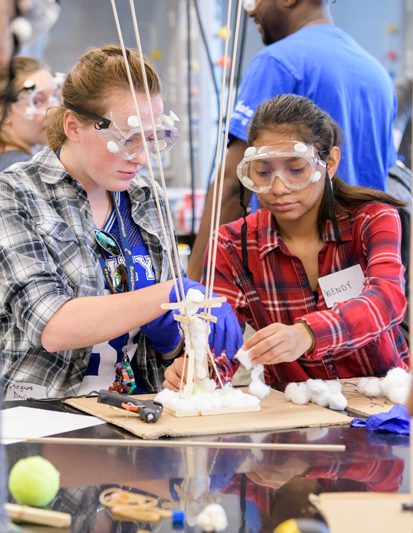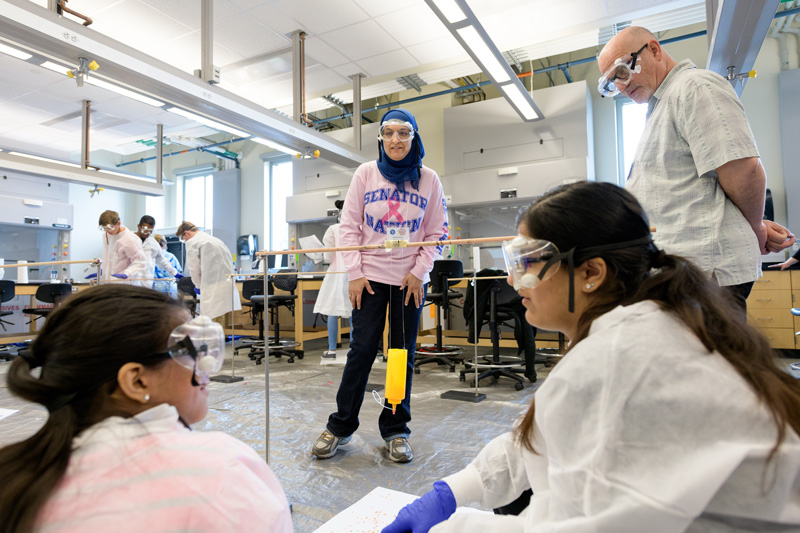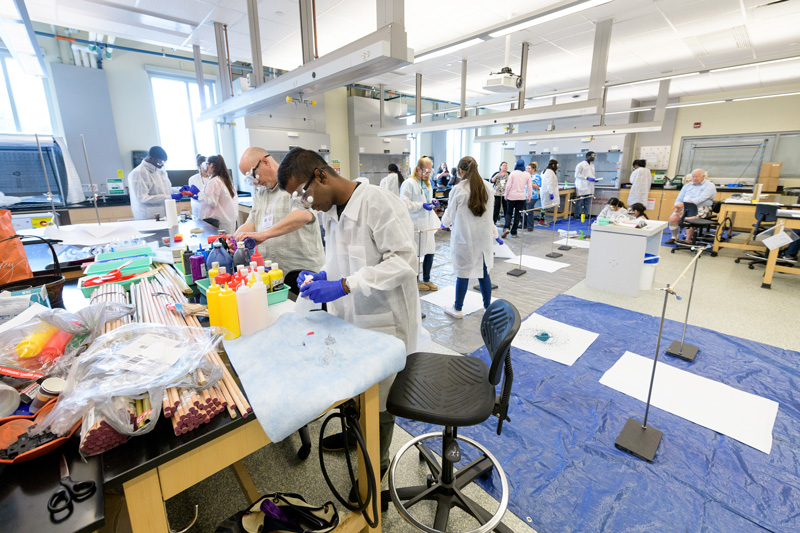

High school students and teachers learning at UD
Photo by Evan Krape July 20, 2018
Nine Delaware schools attend STEAM Summer Academy
Using cups, cotton balls, duct tape and other assorted materials, students were tasked with constructing a building that could withstand an earthquake. From stacking cups to mimicking well known architecture like the Eiffel Tower, students brought to life their best designs. Height, mass and low cost earned them extra points, as the high schoolers tested their buildings on a machine that simulates earthquakes.
This was just one of the labs students participated in during a weeklong science, technology, engineering, arts and math (STEAM) Summer Academy held this summer in the Interdisciplinary Science and Engineering Laboratory (ISE Lab) at the University of Delaware.
High school teachers from across the state worked together to design the labs. The goal for each teaching group was to focus on one theme, but parse it out across disciplines through lab activities and each teacher’s area of expertise. In its fifth year, more than 30 teachers from nine Delaware high schools and about 70 students attended.

The camp serves as an extension of a professional development workshop sponsored by the Delaware Department of Education, the U.S. Department of Education Mathematics-Science Partnership and UD. The winter workshop focused on working across disciplines and ways high school teachers could enhance their lessons.
John Jungck, director of Dupont Interdisciplinary Science Learning Laboratories and principal investigator of the Delaware Interdisciplinary STEAM Citizens Science Project (DISCovery Project) said the question his team is continually trying to answer is, “How do you build the village of support to have students succeed?”
That is the challenge presented to the team of high school teachers, he said, but every year the teams rise to the occasion. That’s why this program benefits not only students, but also teachers, because they get to collaborate in ways they may not be able to during the school year.
“The teachers not only get to work as a team, but reflect upon it,” Jungck said. “They have that time to revise, to get some critique from their peers, to really develop their own teamwork.”
On the Tuesday morning of the weeklong training program, the team of teachers from Padua Academy conducted their lab around the theme of surface tension. They set up various activities for students, including testing how much water can be balanced on a penny, moving boats in trays of water using soap drops and creating art designs in plates of milk with food coloring. The group was made up math, biology and chemistry teachers.
The teachers were able to run their labs a total of four times over two days, and encouraged to make tweaks as they went along. In the afternoon after their first two run-throughs, the Padua teachers and another group of teachers that observed their lab, gathered for a tuning session to dissect and reflect on how the labs went.
Anne Terrell, ISE Lab Preceptor, facilitated this discussion. Her role was to gently guide the conversation, but allow the teachers to converse freely without interjecting her opinions. Following the session, she was pleased with the conversation around improvements and how teachers frame the idea of failure for students.
“I loved that the teachers take a huge amount of ownership of the activities that they design,” Terrell said. “That’s the beauty of this workshop. They are designing. They are implementing and they are testing it on the students so they can see the feasibility when they go back into the classroom.”
Jon Manon, co-principal investigator of the DISCovery Project and retired UD professor, said the program relies on the key component of interdisciplinary collaboration. That’s why he likes the tuning sessions because, “Everyone is willing to provide that feedback,” Manon said.
Patricia Gaynor, a biology teacher from Padua Academy, said the setup of getting feedback in the tuning session and observing other groups teach was eye-opening. One observation she walked away with was just how engaged students could be.
“Every session that I went to, including the one that I was teaching with my team members, it was interesting to see how engaged these students are,” Gaynor said. “You give them activities that are relatable and exciting and hands on and they’re actually learning chemistry. Their eyes are glued onto the teachers that are providing that lesson.”
In addition to the focus on the labs, the program also offered an opportunity to showcase the University to potential future students. A group of undergraduate students were mentors for the high schoolers throughout. The students also participated in a round table discussion with the UD mentors on what it’s like to attend the University and how they managed the transition from high school.
The camp, which was funded by a five year grant from the Delaware DISCovery Project ended this year. Manon said the challenge going forward is to institutionalize this program and find a steady stream of funding. Manon, Jungck and many of the high schools involved are working on securing funding to provide the program again next summer.
On the final day, students participated in various labs including one on hurricane preparedness. The team of teachers from Middletown High School went all out with thunder and wind sounds, alarms and a dark room to simulate a power outage as they educated students on the realities of quick thinking during a hurricane. Students were given a budget and tasked with making decisions in a high stress situation with little time to think things through.
In another lab titled Parametric Representation, Harmony and Chaos, students used different tools to visually represent their functions and discuss the larger concepts from the respected disciplines. William Penn High School teacher Lars Jensen led an activity using a harmonograph — a device that uses pendulums to create geometric artwork. He said he’s found success in creating the artworks first before diving into the concepts behind them.
Upstairs in a separate lab, students created their own pendulum to see what geometric artworks they could create. Nadia Sheikh and Fiza Malik from MOT (Middletown, Odessa and Townsend) Charter High, first attached two strings to a plastic squeeze bottle filled with orange paint. The bottle would only swing back and forth, resulting in a more linear picture.
Dover High School teacher Zubia Majeed challenged the young women to rethink their design, so the pendulum could swing on both axes. They decided to give it another try with just one string, so their paint bottle could swing more freely.
Attending the camp for the second year, Sheikh said she loves learning about all the concepts and participating in the activities.
“It’s been really fun,” she said. “I’ve been able to meet different people and able to see what different schools have in store for different experiments.”
Contact Us
Have a UDaily story idea?
Contact us at ocm@udel.edu
Members of the press
Contact us at 302-831-NEWS or visit the Media Relations website



-and-Melina-Trautman-STEAM-Summer_Academy-062218-080,-EK,-800x533.jpg)
,-Kamren-Sutton,-students,-STEAM_Summer_Academy-062218-EK,095,-800x533.jpg)
